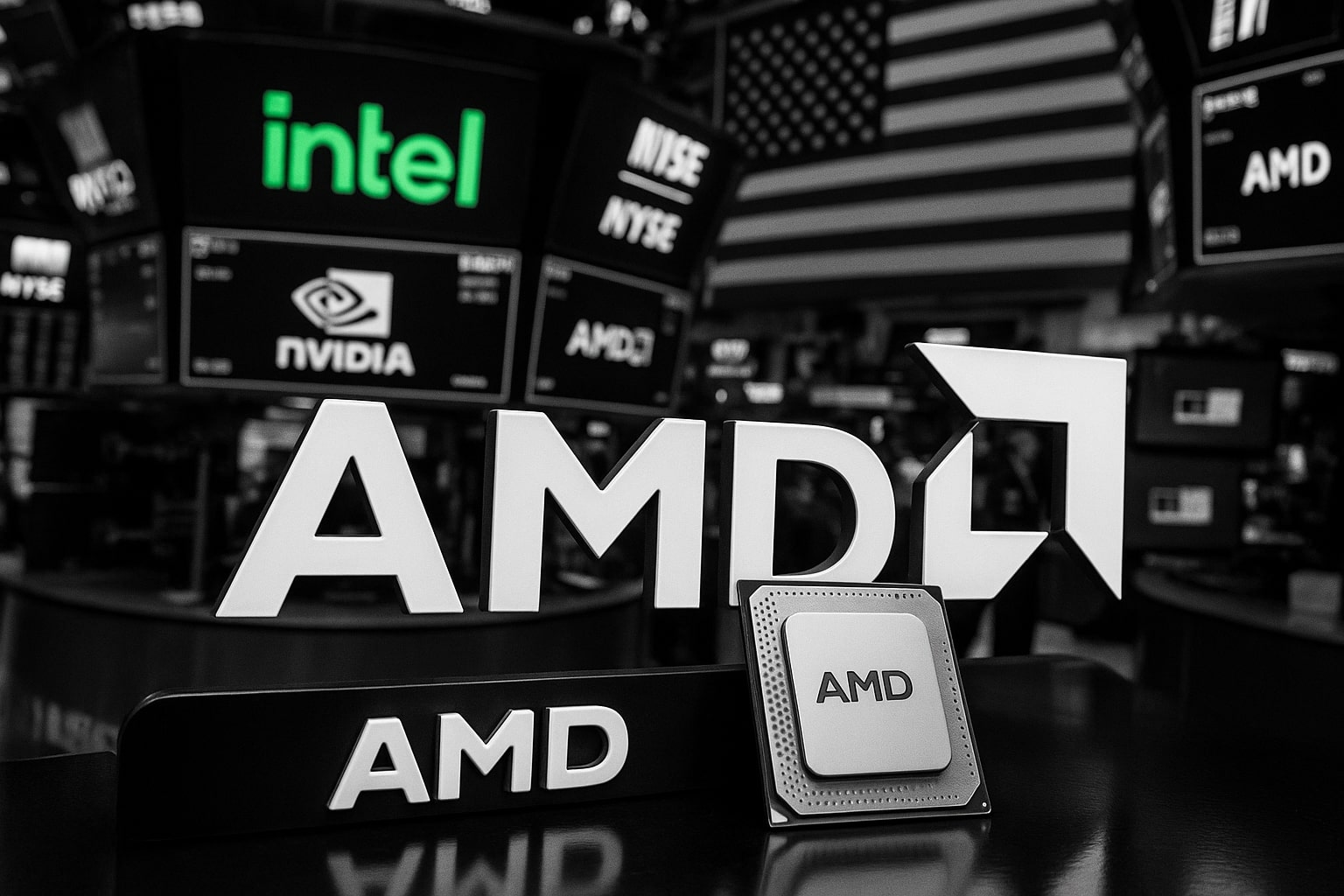
AMD Stock Price Forecast - AMD Jumps to $232 on $100B OpenAI AI Chip Deal and Massive Growth Repricing
NASDAQ:AMD rallies as Lisa Su secures 6-GW OpenAI contract, driving projected AI data center revenue past $100 billion and setting sights on $288–$515 long-term targets | That's TradingNEWS
NASDAQ:AMD Surges Above $232 After Landmark 6-GW OpenAI Deal Ignites $100B AI Revenue Path
AMD’s Strategic Leap into AI Infrastructure
Advanced Micro Devices (NASDAQ:AMD) has reignited investor enthusiasm after unveiling a 6-gigawatt (GW) AI chip supply partnership with OpenAI, a deal that CEO Lisa Su described as “transformative for AMD’s long-term data center ambitions.” The stock jumped over 6.5% to $232.65, reaching within striking distance of its 52-week high of $240.10, as traders revalued AMD’s role in the fast-expanding AI hardware ecosystem.
This partnership comes as AMD battles NVIDIA’s (NASDAQ:NVDA) entrenched dominance in GPU computing. The agreement gives OpenAI warrants representing roughly 10% of AMD’s equity, a $35 billion equivalent at current valuation. In exchange, AMD secures a multiyear hardware contract that could generate over $150 billion in AI infrastructure revenue by 2030, solidifying its position as the second force in AI computing.
The Economic Logic Behind the Dilution
While the move initially raised eyebrows due to dilution concerns, management insists the equity component is a calculated trade-off for market share acceleration. “I’d rather own 90% of a trillion-dollar AMD than 100% of a $300 billion company,” a sentiment echoed by investors who see this as a strategic bet similar to NVIDIA’s $100B commitment to OpenAI. AMD’s deal structure ensures immediate accretive value to earnings per share (EPS) upon revenue recognition starting H2 2026, with revenue contributions expected to grow to double-digit billions annually by 2027.
Financially, AMD projects strong operating leverage due to its fabless model. CFO Jean Hu noted that as deployments ramp, “gross margin dollars will expand significantly,” bringing AMD’s profitability closer to NVIDIA’s as volumes scale. The model implies potential non-GAAP EPS growth above 30% CAGR over the next three years, driven by high-margin data center sales.
AMD’s Valuation Realignment: Fair Value Raised to $288
Following the OpenAI announcement, analysts revalued AMD’s fair value from $240 to $288 per share, implying roughly +33% upside from current levels. The company’s enterprise value surged to $377 billion, reflecting market expectations of accelerated revenue expansion. Consensus now forecasts FY2025 revenue at $33.1 billion, rising to $41.9 billion in 2026, marking a 26.7% YoY growth trajectory.
The price-to-sales ratio remains elevated at 9.36, justified by expected AI-driven sales momentum and the anticipated scale of Helios and MI450x GPU shipments. AMD’s forward P/E ratio has compressed to 28.5, signaling valuation normalization as profits scale. At the current EPS estimate of $3.92 for FY2025 and $6.27 for FY2026, the forward multiple suggests strong investor confidence in execution.
Technical Structure and Market Momentum
Technically, AMD (NASDAQ:AMD) has maintained an upward trajectory since its August 2025 breakout above $200. The rally mirrors the AI-sector rotation, with traders citing momentum confirmation above $220 and the next resistance set at $240–$245. Support remains firm at $214.50, with heavy institutional positioning—69.1% of shares held by funds—providing stability.
Momentum indicators show relative strength but not overextension. The 14-day RSI at 68 and rising volume average above 61 million shares confirm sustained institutional accumulation. The bullish structure is further reinforced by AMD’s 315% three-year total return, significantly outperforming the S&P 500’s 85.13% in the same period.
Data Center Transformation and AI Compute Expansion
Lisa Su’s roadmap envisions AMD’s data center segment becoming the company’s primary revenue driver, leveraging the MI355x and Helios AI GPU systems. The 6-GW OpenAI deployment represents only part of AMD’s broader expansion, with multiple MI450 engagements underway with hyperscalers like Oracle (NYSE:ORCL), Meta, and Amazon Web Services (AWS).
Each 1-GW deployment currently yields $60–$80 billion in infrastructure opportunity, suggesting AMD’s involvement in the AI infrastructure boom could exceed $150 billion in direct compute sales. Beyond raw sales, the company anticipates indirect ecosystem benefits as its ROCm platform gains wider adoption—challenging NVIDIA’s CUDA monopoly and diversifying AI workloads across open standards.
Financial Backbone: Robust Balance Sheet and Cash Reserves
AMD’s fundamentals remain resilient. The company holds $5.87 billion in cash with total debt of $3.89 billion, maintaining a conservative 6.51% debt-to-equity ratio and a 2.49 current ratio, showcasing strong liquidity to fund ongoing R&D and potential acquisitions. With a 9.57% profit margin and 31.7% YoY quarterly revenue growth, AMD’s operational metrics point to sustained financial health despite short-term margin pressure.
Free cash flow remains positive at $2.33 billion, and levered FCF margins are expected to expand toward 30% by FY2027, supported by operational scale and improving yields from TSMC’s advanced process nodes.
Read More
-
Palantir Stock Price Forecast - Can a $440B AI Defense Powerhouse Grow Into Its $184.74 Price?
16.12.2025 · TradingNEWS ArchiveStocks
-
XRP Price Forecast - XRP-USD Drops to $1.87 as Whale Dumps $721M While XRP ETFs Quietly Cross $1B
16.12.2025 · TradingNEWS ArchiveCrypto
-
Oil Price Forecast - Oil Slide Hard; WTI CL=F Near $55, Brent BZ=F Below $60 as Market Bets on 2026 Supply Glut
16.12.2025 · TradingNEWS ArchiveCommodities
-
Stock Market Today: Dow (^DJI) 48,404 And S&P 500 (^GSPC) 6,812 Slip As Jobs Hit +64K And AVGO Sells Off
16.12.2025 · TradingNEWS ArchiveMarkets
-
GBP/USD Price Forecast - Pairs at 1.34 as Weak U.S. Jobs Data Clash with BoE Cut Bets into Year-End
16.12.2025 · TradingNEWS ArchiveForex
AMD vs. NVIDIA and Broadcom: AI Power Realignment
While NVIDIA retains a $4.34 trillion market capitalization, AMD’s recent surge positions it as a credible challenger. Broadcom’s (NASDAQ:AVGO) AI partnership portfolio and AMD’s OpenAI deal mark a structural shift in the AI GPU oligopoly, distributing compute supply across multiple vendors to mitigate dependency risk.
AMD’s approach—trading equity exposure for long-term contractual revenue—aligns strategically with OpenAI’s diversification model, creating an AI circular economy where chipmakers, hyperscalers, and AI developers cross-fund one another’s infrastructure growth.
Earnings Growth Outlook and Analyst Consensus
According to consensus estimates, AMD’s Q3 FY2025 EPS is expected at $1.17, rising to $1.32 in Q4, reflecting +27% QoQ growth. Annual earnings could reach $3.92 in 2025 and $6.27 in 2026, representing a +59.7% YoY expansion. Analysts remain overwhelmingly bullish, with HSBC recently raising its price target to $310, maintaining a “Buy” rating. Quant models also rank AMD as a “Strong Buy” (4.81/5) across all AI metrics.
The company’s 5-year target of $515/share, derived from a 20x P/FCF exit multiple, implies a 19% compound annual growth rate, suggesting sustained upside through the end of the decade.
Verdict: AMD Positioned for Structural AI Dominance
With NASDAQ:AMD now trading near $232 and fair value models signaling upside toward $288–$515, the company stands at a critical inflection point. The OpenAI alliance not only diversifies AMD’s customer base but also validates its AI compute architecture as a viable alternative to NVIDIA’s ecosystem. While short-term dilution remains a risk, the long-term reward profile and scalability potential outweigh near-term earnings compression.
Final stance: Buy. AMD is entering a phase of structural hypergrowth, underpinned by AI infrastructure expansion, robust balance sheet strength, and execution under Lisa Su’s leadership. The path toward $500+ per share remains credible as AMD cements its role as a global AI infrastructure cornerstone.
View Real-Time Chart for NASDAQ:AMD


















